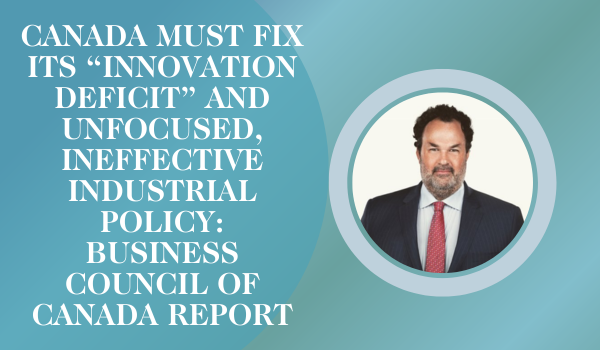Targeted government procurement is the key to boosting Canada’s productivity, Council of Canadian Innovators says
Mark LoweySeptember 18, 2024
More government procurement aimed at supporting technology companies with potential to grow into global firms is the key to improving Canada’s productivity, according to a new report by the Council of Canadian Innovators (CCI).
In today’s knowledge-based and data-driven economy driven by strategic competition, the days of “hands-off” innovation are long gone, and Canada needs a new approach to innovation and industrial policy, says the report, Building Winners: Strategic Procurement in the Age of Innovation.
“Canada is currently failing to use the most powerful government tool for economic development,” which is public procurement, the report’s co-authors argue.
 Canada has a gap in its “economic software,” report co-author Laurent Carbonneau (photo at right) CCI’s director of policy and research, said during CCI’s online launch of the report.
Canada has a gap in its “economic software,” report co-author Laurent Carbonneau (photo at right) CCI’s director of policy and research, said during CCI’s online launch of the report.
We live in a new economic world with high producer rents [supernormal profits] driven by information technologies, superstar firms driving productivity growth, and a lot of uncertainty, he said.
For example, artificial intelligence developer OpenAI in the U.S. expects to spend US$5 billion (Cdn$6.81 billion) in 2024. In comparison, Canada’s federal budget allocates a total of Cdn$4.6 billion for innovation support.
Carbonneau said in looking at the economic fundamentals of countries with thriving economies, a lot of their productivity growth is driven by a small number of large firms at the global leading edge technologically.
But in Canada, he said, “we don’t have enough of those big innovative domestic companies. We need more scale. That’s really the game here.”
 Canada lacks the interconnected innovation ecosystem that the U.S. built upon following the Second World War to produce military and national defense products, said CCI report co-author Dan Ciuriak (photo at left) fellow at the Centre for International Governance Innovation and the C.D. Howe Institute.
Canada lacks the interconnected innovation ecosystem that the U.S. built upon following the Second World War to produce military and national defense products, said CCI report co-author Dan Ciuriak (photo at left) fellow at the Centre for International Governance Innovation and the C.D. Howe Institute.
The military innovation ecosystem, including the Defense Advanced Research Projects Agency which connected industry, universities, the military and other government departments, “became the face of American industrial policy,” he said.
However, like Canada, the U.S.’s civilian innovation ecosystem was disconnected after the Second World War, Ciuriak noted.
“When the U.S. disconnected the innovation ecosystem along the whole path, from primary science through to the end-customer being involved in the innovation process, that system languished and America started to fall behind.”
But in 1980, Ciuriak noted, the Bayh-Doyle Act – which encouraged the commercialization of knowledge produced in the U.S. system of colleges and universities – reconnected some of the U.S. civilian innovation ecosystem.
“Having that connection [along the whole innovation path] is absolutely critical for Canada,” Ciuriak said.
Impacts of the Bayh-Doyle Act included a tenfold increase in patents generated, 2,200 spinoff firms, 260,00 jobs and US$40 billion in annual contributions to the American economy.
“The partially reconnected system in the United States stimulated by the Bayh-Dole Act revitalized American innovation,” the CCI’s report says.
 Neil Desai (photo at right) senior fellow at the Centre for Governance and Innovation, said Canada is falling down on “value-based” procurement.
Neil Desai (photo at right) senior fellow at the Centre for Governance and Innovation, said Canada is falling down on “value-based” procurement.
This essentially involves competing with human capital and trying to do things more efficiently or safely or deliver an outcome that doesn’t currently exist, he said.
“That’s the opportunity that’s being missed from Canada, where we could be fulfilling global markets and technologies that we’re just imagining today,” Desai said.
There’s a lot of money in Canada’s innovation ecosystem, but the country’s economic development is separated from government procurement, he added.
Desai, previously a member of the leadership team at Waterloo-based digital forensics firm Magnet Forensics, which went public and sold for $1.8 billion, said the private market doesn’t adequately value the publicly funded “economic development dollar” provided by government grants, tax credits and innovation programs. Rather, the marketplace values a company’s revenues which come from selling products.
The dollars invested by government in innovative companies are never tied to a commercially driven outcome, Desai said.
 Nicole Janssen (photo at right) co-founder and co-CEO of Edmonton-headquartered AltaML, an applied AI laboratory, agreed with Desai about the value the private market places on government procurement versus government innovation funding.
Nicole Janssen (photo at right) co-founder and co-CEO of Edmonton-headquartered AltaML, an applied AI laboratory, agreed with Desai about the value the private market places on government procurement versus government innovation funding.
“I can’t tell you the credibility that you earn by having a government logo on your client roster – it is huge,” she said.
“That credibility extends across to other customers, it extends beyond the Canadian borders. To know that your services are being procured by government is massive.”
“Stop doing things that don’t work and focus on things that do”
Public procurement makes up about 15 percent of Canada’s GDP and 27 percent of public spending, according to CCI’s report.
But Canadian governments do not systematically use this demand-side buying power as an innovation policy lever, preferring to use supply-side measures like tax credits and grants instead, the report says. “Unlike in other countries like the United States, Finland and the United Kingdom, procurement is Canada’s sleeping innovation policy giant.”
With the government acting as a large anchor buyer, procurement can de-risk the investments in innovation and fortify mid-sized domestic firms that have not yet achieved the status of global superstar companies, the report notes. “By targeting innovation that meets public needs, procurement serves as an innovation catalyst.”
Perhaps most importantly, the report adds, as a central player, the government is well-positioned to bring innovation networks together and organize the firms, researchers, educational institutions and community organizations.
“It has never been more important as an economy to be a country where industry-leading firms grow and stay,” the report says.
Yet Canada is failing to meet its goal of doubling the number of high-growth firms from 14,000 to 28,000, as targeted in the federal government’s 2017 Skills and Innovation Plan. As of 2021, the number of Canadian high-growth firms languished at 14,070, according to Statistics Canada.
CCI’s report points out that Canada’s economy faces several widely acknowledged problems: lagging productivity growth and innovation; stagnating per capita income growth; and failure at scaling enough globally successful firms.
“These are often treated as related but separate problems. In fact, they are simply different facets of one problem: Canada’s firms struggle to scale,” the report says.
Larger firms have the tools to be more productive, more innovative and more trade oriented. Most of a country’s productivity growth and innovation are contributed by a small set of high-growth firms – firms that are scaling up rapidly and engaging in trade.
Within the industrial policy toolkit, procurement is the tool that is most directly targeted as it can be structured to put promising firms on a fast-track to scale, supported by proprietary intellectual property, the report says.
This approach buys companies the “freedom to operate,” which is essential for scaling, and enables firms to generate supernormal profits, or economic rents, thereby contributing to measured productivity growth.
Canada lacks a critical mass of scaling firms that drive innovation, productivity and growth, the report says. “A country with a firm-structure problem – characterized by too few scalable firms with valuable intellectual property – lacks ‘winners’ to back and must therefore help to build them.”
The report cites some notable industrial policy initiatives around the world, including:
- The U.S. Advanced Manufacturing Partnership implemented by the U.S. federal government in 2011.
- Germany’s “Industry 4.0” announced at the Hannover industrial fair in 2011.
- Japan’s “4.1J” advanced manufacturing program launched in 2016 and the Connected Industries initiative in 2017.
- Korea’s “Connected Smart Factory” initiative begun in 2016.
- Taiwan’s “Smart Machine and Productivity 4.0” initiative launched in 2016.
- China’s “Made in China 2025” program and the “China AI 2030” initiative.
“We need to stop spreading ‘peanut butter,’ stop doing things that don’t work and focus on things that do,” Carbonneau said.
The report’s recommendations include: creating a new dedicated federal procurement agency; setting government procurement targets for small and medium-sized Canadian businesses; and centralizing and making available innovation procurement expertise to public servants across government.
Canada’s innovation system needs to be more agile, outcome-oriented
Janssen from AltaML said the decision to create the applied AI-focused initiative was decided at the top levels of the Alberta government, which wanted an agile initiative that would develop talent, commercialize products and make AI solutions operational.
All provincial government departments put forward their ideas for AI and they all compete for a pool of money, Janssen said.
AltaML, which is focused on developing AI-driven solutions, is tackling problems such as cancer wait times, wildfire prediction, understanding where to place school investments and the impacts this has on surrounding communities and schools, and other big societal challenges.
AltaML’s process includes a “time-box” limit of four months for projects, and then government departments and AI technology providers have to earn another four months to extend projects, Janssen said. “It forces the agility on the approach.”
AltaML, which has been operational for two years, has been talking to the federal government for about a year and half, but many federal departments don’t have in-house expertise to assess novel technologies, Janssen said.
“We get to the same place every time in every conversation [with the federal government saying]: ‘We don’t know how to procure this.’ That’s where we sit on everything. Everybody loves the idea, but no one knows how to procure it, so then it dies.”
The federal approach is “more about, ‘How do we control this? This is my fiefdom and I want to control this,’” Janssen said. “It’s not about making it happen, but rather about controlling it.”
Desai said Canada needs to start creating incentives for the professional civil service at the operational, policy and procurement levels, to be agile and take risks in procuring innovative products for government.
“Currently there’s a disincentive. You actually will stunt your career by increasing your risk in your procurement, by trying to co-develop or buying domestically,” he said. “We need to promote people who are actually failing, but failing and mitigating risk.”
Ciuriak said he doesn’t think it’s well understood in Canada’s public policy sphere that firms are the “software” of the country’s economy.
“We allow irreplaceable firms like Nortel to fail and be taken apart as if it had been a failed clothing retailer amongst a hundred other clothing retailers.”
Ciuriak said the federal government at the time should have nationalized the pioneering telecom and data networking manufacturer, the way Edward Heath’s British Tory government in 1971 nationalized the Rolls-Royce jet engine division when it ran into cost overruns on developing a new generation of jet engines. After surviving a financial collapse, Rolls-Royce was then re-privatized by the Margaret Thatcher government in 1987, with new management.
Canada, by actively promoting itself “as low-cost R&D suppliers, means we are the hewers of wood and the drawers of water in this knowledge-based economy, selling our R&D services to create IP which we then buy back at a premium price,” Ciuriak said.
Desai said Canada’s innovation ecosystem is very much process-oriented and not outcome-oriented.”
For example, governments don’t realize, in the world of generative AI, the value of government data, including who gets access to it and how it can be leveraged for economic outcomes in health, public safety, cybersecurity and other areas, he said.
Desai said Canada also needs to expand its number of financial utilities to help achieve outcomes, enable co-development and implement initiatives such as advanced purchase orders, which he said he has never seen in Canadian government procurement.
People talk about productivity in Canada as if it’s this complex idea, but it’s not,” he said. “It’s doing more with less, that’s all it is.”
NOTE: The CCI released an earlier and related report in April 2024 on public procurement reform, titled Buying Ideas: Procuring Public Sector Innovation in Canada.
R$
Events For Leaders in
Science, Tech, Innovation, and Policy
Discuss and learn from those in the know at our virtual and in-person events.
See Upcoming Events
You have 0 free articles remaining.
Don't miss out - start your free trial today.
Start your FREE trial Already a member? Log in
By using this website, you agree to our use of cookies. We use cookies to provide you with a great experience and to help our website run effectively in accordance with our Privacy Policy and Terms of Service.




